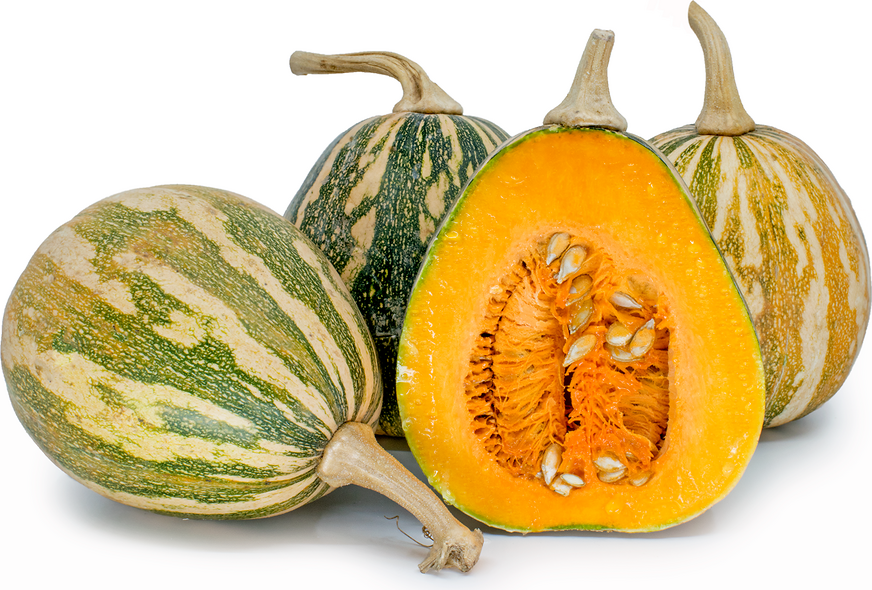


Fairy Squash
Estimated Inventory, lb : 0
Description/Taste
Fairy squash is small in size and lightweight, averaging only two pounds, and has an oval to pear-like shape. The rind has variegated patterns of tan and green striping when young, and it eventually loses some of its green stripes fading into an orange, gold, and light green with maturity. The firm flesh is a rich, deep orange and is dense and moist with a large hollow cavity containing stringy pulp and many flat, cream-colored seeds. When cooked, Fairy squash is tender and velvety with a sweet, nutty flavor.
Seasons/Availability
Fairy squash is available in the late fall through winter.
Current Facts
Fairy squash, botanically classified as Cucurbita moschata, is a small winter squash that grows on trailing vines and is a member of the Cucurbitaceae family along with pumpkins and gourds. Fair squash is a hardy, disease resistant, and a prolific growing hybrid squash, but it has not had the commercial success of other similarly sized squashes such as acorn and carnival as a result of its hybrid designation. The seeds of hybrid squash cannot produce similar squashes in consecutive generations, so to grow year after year, new seeds must be purchased from seed distributors each season which makes it an expensive variety to grow. Due to its hybrid nature, Fairy squash is predominately grown in home gardens as a specialty variety, and its numerous squash blossoms can also be fried, stuffed, and consumed in culinary applications.
Nutritional Value
Fairy squash contains vitamins A, C, and E, potassium, soluble fiber, beta-carotene, and magnesium.
Applications
Fairy squash is best suited for cooked applications such as roasting, baking, steaming, or grilling and can be used in both savory and sweet recipes. It can be cooked and added to soups, stews, risotto, and curries, or served in wedges or halved as an accompaniment to roasted meats. Fairy squash is also the ideal size for stuffing, baking, and serving as an edible bowl. Pureed Fairy squash can be added to thicken soups and sauces or used in bread, pies, and puddings. Its flavor profile is similar to and can be readily substituted in recipes calling for butternut squash. The blossoms of the Fairy squash can also be used and are ideal for stuffing with soft cheeses and herbs. Fairy squash pairs well with butter, brown sugar, rosemary, sage, ginger, chiles, cinnamon, nutmeg, pecans, chestnuts, parmesan cheese, ricotta cheese, pears, apples, raisins, poultry, and pork. It will keep for a couple of months when stored in a cool, dry, and dark place.
Ethnic/Cultural Info
The earliest written records of Fairy squash were in a recipe for Fairy squash pie by Emma C. Matern in the 1905-1906 publication of the Boston Cooking School Magazine and also in the 1920 cookbook put out by Crisco titled, Balanced Daily Diet. The ingredients in the recipes call for pureed squash and whether or not it specifically refers to the Fairy squash or just a general squash is not known, but the title of the recipes is the earliest record of the name Fairy squash that can be found.
Geography/History
The Fairy squash's family, Cucurbita moschata, is believed to date back to 5,000 BCE in Mexico and 3,000 BCE in Peru. The exact origin of the Fairy squash is unknown, but since it is a hybrid, it was likely developed sometime in the twentieth century when hybrid squashes were becoming popular in the marketplace. Today Fairy squash is grown predominantly by home gardeners and specialty growers in the United States and is limited in availability.
Recipe Ideas
Recipes that include Fairy Squash. One
| Ideas in Food |
|
Raw Squash Consomme |




